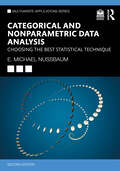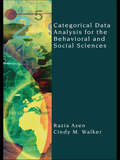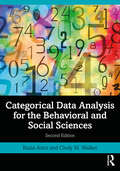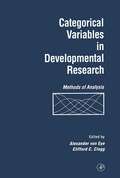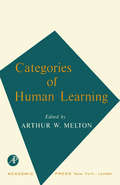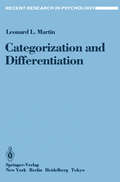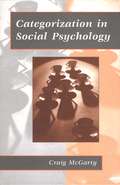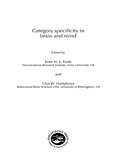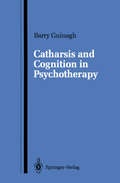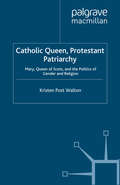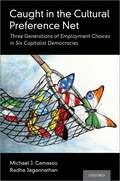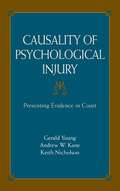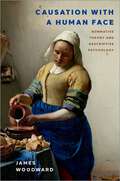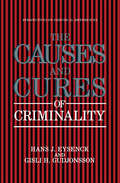- Table View
- List View
Categorical and Nonparametric Data Analysis: Choosing the Best Statistical Technique (Multivariate Applications Series)
by E. Michael NussbaumNow in its second edition, this book provides a focused, comprehensive overview of both categorical and nonparametric statistics, offering a conceptual framework for choosing the most appropriate test in various scenarios. The book’s clear explanations and Exploring the Concept boxes help reduce reader anxiety. Problems inspired by actual studies provide meaningful illustrations of these techniques. Basic statistics and probability are reviewed for those needing a refresher with mathematical derivations placed in optional appendices.Highlights include the following:• Three chapters co-authored with Edgar Brunner address modern nonparametric techniques, along with accompanying R code.• Unique coverage of both categorical and nonparametric statistics better prepares readers to select the best technique for particular research projects.• Designed to be used with most statistical packages, clear examples of how to use the tests in SPSS, R, and Excel foster conceptual understanding.• Exploring the Concept boxes integrated throughout prompt students to draw links between the concepts to deepen understanding.• Fully developed Instructor and Student Resources featuring datasets for the book's problems and a guide to R, and for the instructor PowerPoints, author's syllabus, and answers to even-numbered problems.Intended for graduate or advanced undergraduate courses in categorical and nonparametric statistics taught in psychology, education, human development, sociology, political science, and other social and life sciences.
Categorical Data Analysis for the Behavioral and Social Sciences
by Razia Azen Cindy M. WalkerFeaturing a practical approach with numerous examples, this book focuses on helping the reader develop a conceptual, rather than technical, understanding of categorical methods, making it a much more accessible text than others on the market. The authors cover common categorical analyses and emphasize specific research questions that can be addressed by each analytic procedure so that readers are able to address the research questions they wish to answer. To achieve this goal, the authors: Review the theoretical implications and assumptions underlying each of the procedures Present each concept in general terms and illustrate each with a practical example Demonstrate the analyses using SPSS and SAS and show the interpretation of the results provided by these programs. A "Look Ahead" section at the beginning of each chapter provides an overview of the material covered so that the reader knows what to expect. This is followed by one or more research questions that can be addressed using the procedure(s) covered in the chapter. A theoretical presentation of the material is provided and illustrated using realistic examples from the behavioral and social sciences. To further enhance accessibility, the new procedures introduced in the book are explicitly related to analytic procedures covered in earlier statistics courses, such as ANOVA and linear regression. Throughout each chapter the authors use practical examples to demonstrate how to obtain and interpret statistical output in both SPSS and SAS. Their emphasis on the relationship between the initial research question, the use of the software to carry out the analysis, and the interpretation of the output as it relates to the initial research question, allows readers to easily apply the material to their own research. The data sets for executing chapter examples using SAS Version 9.1.3 and/or IBM SPSS Version 18 are available on a book specific web site. These data sets and syntax allow readers to quickly run the programs and obtain the appropriate output. The book also includes both conceptual and analytic end-of-chapter exercises to assist instructors and students in evaluating the understanding of the material covered in each chapter. This book covers the most commonly used categorical data analysis procedures. It is written for those without an extensive mathematical background, and is ideal for graduate courses in categorical data analysis or cross-classified data analysis taught in departments of psychology, human development & family studies, sociology, education, and business. Researchers in these disciplines interested in applying these procedures to their own research will appreciate this book’s accessible approach.
Categorical Data Analysis for the Behavioral and Social Sciences
by Razia Azen Cindy M. WalkerFeaturing a practical approach with numerous examples, this book focuses on helping the reader develop a conceptual, rather than technical, understanding of categorical methods, making it a much more accessible text than others on the market. The authors cover common categorical analyses and emphasize specific research questions that can be addressed by each analytic procedure so that readers are able to address the research questions they wish to answer. To achieve this goal, the authors: Review the theoretical implications and assumptions underlying each of the procedures Present each concept in general terms and illustrate each with a practical example Demonstrate the analyses using SPSS and SAS and show the interpretation of the results provided by these programs. A "Look Ahead" section at the beginning of each chapter provides an overview of the material covered so that the reader knows what to expect. This is followed by one or more research questions that can be addressed using the procedure(s) covered in the chapter. A theoretical presentation of the material is provided and illustrated using realistic examples from the behavioral and social sciences. To further enhance accessibility, the new procedures introduced in the book are explicitly related to analytic procedures covered in earlier statistics courses, such as ANOVA and linear regression. Throughout each chapter the authors use practical examples to demonstrate how to obtain and interpret statistical output in both SPSS and SAS. Their emphasis on the relationship between the initial research question, the use of the software to carry out the analysis, and the interpretation of the output as it relates to the initial research question, allows readers to easily apply the material to their own research. The data sets for executing chapter examples using SAS Version 9.1.3 and/or IBM SPSS Version 18 are available on a book specific web site. These data sets and syntax allow readers to quickly run the programs and obtain the appropriate output. The book also includes both conceptual and analytic end-of-chapter exercises to assist instructors and students in evaluating the understanding of the material covered in each chapter. This book covers the most commonly used categorical data analysis procedures. It is written for those without an extensive mathematical background, and is ideal for graduate courses in categorical data analysis or cross-classified data analysis taught in departments of psychology, human development & family studies, sociology, education, and business. Researchers in these disciplines interested in applying these procedures to their own research will appreciate this book’s accessible approach.
Categorical Data Analysis for the Behavioral and Social Sciences
by Razia Azen Cindy M. WalkerFeaturing a practical approach with numerous examples, the second edition of Categorical Data Analysis for the Behavioral and Social Sciences focuses on helping the reader develop a conceptual understanding of categorical methods, making it a much more accessible text than others on the market. The authors cover common categorical analysis methods and emphasize specific research questions that can be addressed by each analytic procedure, including how to obtain results using SPSS, SAS, and R, so that readers are able to address the research questions they wish to answer. Each chapter begins with a "Look Ahead" section to highlight key content. This is followed by an in-depth focus and explanation of the relationship between the initial research question, the use of software to perform the analyses, and how to interpret the output substantively. Included at the end of each chapter are a range of software examples and questions to test knowledge. New to the second edition: The addition of R syntax for all analyses and an update of SPSS and SAS syntax. The addition of a new chapter on GLMMs. Clarification of concepts and ideas that graduate students found confusing, including revised problems at the end of the chapters. Written for those without an extensive mathematical background, this book is ideal for a graduate course in categorical data analysis taught in departments of psychology, educational psychology, human development and family studies, sociology, public health, and business. Researchers in these disciplines interested in applying these procedures will also appreciate this book’s accessible approach.
Categorical Data Analysis for the Behavioral and Social Sciences
by Razia Azen Cindy M. WalkerFeaturing a practical approach with numerous examples, the second edition of Categorical Data Analysis for the Behavioral and Social Sciences focuses on helping the reader develop a conceptual understanding of categorical methods, making it a much more accessible text than others on the market. The authors cover common categorical analysis methods and emphasize specific research questions that can be addressed by each analytic procedure, including how to obtain results using SPSS, SAS, and R, so that readers are able to address the research questions they wish to answer. Each chapter begins with a "Look Ahead" section to highlight key content. This is followed by an in-depth focus and explanation of the relationship between the initial research question, the use of software to perform the analyses, and how to interpret the output substantively. Included at the end of each chapter are a range of software examples and questions to test knowledge. New to the second edition: The addition of R syntax for all analyses and an update of SPSS and SAS syntax. The addition of a new chapter on GLMMs. Clarification of concepts and ideas that graduate students found confusing, including revised problems at the end of the chapters. Written for those without an extensive mathematical background, this book is ideal for a graduate course in categorical data analysis taught in departments of psychology, educational psychology, human development and family studies, sociology, public health, and business. Researchers in these disciplines interested in applying these procedures will also appreciate this book’s accessible approach.
Categorical Variables in Developmental Research: Methods of Analysis
by Alexander Von Eye Clifford C. CloggCategorical Variables in Developmental Research provides developmental researchers with the basic tools for understanding how to utilize categorical variables in their data analysis. Covering the measurement of individual differences in growth rates, the measurement of stage transitions, latent class and log-linear models, chi-square, and more, the book provides a means for developmental researchers to make use of categorical data.Measurement and repeated observations of categorical data Catastrophe theoryLatent class and log-linear modelsApplications
Categories of Human Learning
by Arthur W. MeltonCategories of Human Learning covers the papers presented at the Symposium on the Psychology of Human Learning, held at the University of Michigan, Ann Arbor on January 31 and February 1, 1962. The book focuses on the different classifications of human learning. The selection first offers information on classical and operant conditioning and the categories of learning and the problem of definition. Discussions focus on classical and instrumental conditioning and the nature of reinforcement; comparability of the forms of human learning; conditioning experiments with human subjects; and subclasses of classical and instrumental conditioning. The text then takes a look at the representativeness of rote verbal learning and centrality of verbal learning. The publication ponders on probability learning, evaluation of stimulus sampling theory, and short-term memory and incidental learning. Topics include short-term retention, stimulus variation experiments, reinforcement schedules and mean response, systematic interpretations, and methodological approaches. The book then examines the behavioral effects of instruction to learning, verbalizations and concepts, and the generality of research on transfer functions. The selection is highly recommended for psychologists and educators wanting to conduct studies on the categories of human learning.
Categorization and Differentiation: A Set, Re-Set, Comparison Analysis of the Effects of Context on Person Perception (Recent Research in Psychology)
by Leonard L. MartinIn the context of interpersonal interaction, it is possible to characterize human beings as complex sources of information. When interacting with one another, people in tentionally, as well as unintentionally, emit cues which other people can use as a basis for generating inferences and forming impressions about them. As a rule, the informa tion that one receives about another person is complex, mutable, and multidimensional. Often, it is contradictory. One of the more enduring lines of investigation in social psychology has been concerned with understanding the processes whereby people mold such diverse information into a single, unified impression. The linear approach The most influential approach to this issue in recent years has been Anderson's information integration theory (e. g. , Anderson, 1974). The goal of this approach to im pression formation is the formulation of an algebraic model which describes the relation between stimulus input charac teristics and reported judgments. According to information integration theory, a stimulus is characterized hy two parameters: scale value and weight. The scale value of a stimulus represents the perceiver's subjective response to the information on the dimension of judgment (e. g. , good-bad, light-heavy, like-dislike). The weight of a stimulus is its importance or relevance to the judgment. It is perhaps best conceptualized as the proportion that each element of a compound stimulus contributes to the overall evaluation of the compound.
Categorization in Social Psychology (PDF)
by Craig McgartyCategorization in Social Psychology offers a major introduction to the study of categorization, looking especially at links between categorization in cognitive and social psychology. In a highly readable and accessible style, the author covers all the main approaches to categorization in social psychology that a student might come across, including: biased stimulus processing, construct actviation, self-categorization, explanation-based, social judgeability and assimilation/contrast approaches. It is a wide-ranging and up-to-date treatment of concepts from cognitive as well as social psychology.
Category Specificity in Brain and Mind (Brain, Behaviour and Cognition)
by Emer M.E. Forde Glyn W. HumphreysSome of the most fascinating deficits in neuropsychology concern the failure to recognise common objects from one semantic category, such as living things, when there is no such difficulty with objects from another, such as non-living things. Over the past twenty years, numerous cases of these 'category specific' recognition and naming problems have been documented and several competing theories have been developed to account for the patients' disorders.Category Specificity in Brain and Mind draws together the neuropsychological literature on category-specific impairments, with research on how children develop knowledge about different categories, functional brain imaging work and computational models of object recognition and semantic memory. The chapters are written by internationally leading psychologists and neuroscientists and the result is a review of the most up-to-date thinking on how knowledge about different categories is acquired and organized in the mind, and where it is represented in the human brain. The text will be essential reading for advanced undergraduates and researchers in the field of category specificity and a rich source of information for neuropsychologists, experimental and developmental psychologists, cognitive scientists and philosophers.
Category Specificity in Brain and Mind (Brain, Behaviour and Cognition)
by Emer Forde Glyn HumphreysSome of the most fascinating deficits in neuropsychology concern the failure to recognise common objects from one semantic category, such as living things, when there is no such difficulty with objects from another, such as non-living things. Over the past twenty years, numerous cases of these 'category specific' recognition and naming problems have been documented and several competing theories have been developed to account for the patients' disorders.Category Specificity in Brain and Mind draws together the neuropsychological literature on category-specific impairments, with research on how children develop knowledge about different categories, functional brain imaging work and computational models of object recognition and semantic memory. The chapters are written by internationally leading psychologists and neuroscientists and the result is a review of the most up-to-date thinking on how knowledge about different categories is acquired and organized in the mind, and where it is represented in the human brain. The text will be essential reading for advanced undergraduates and researchers in the field of category specificity and a rich source of information for neuropsychologists, experimental and developmental psychologists, cognitive scientists and philosophers.
Catharsis and Cognition in Psychotherapy
by Barry GuinaghThe origin of this book goes back to the fall of 1971. I was beginning my fourth year as an Assistant Professor of Educational Psychology at the University of Florida when I became depressed. I went into psychotherapy, and after much emotional pain, learned to grieve for my handicapped son. While in therapy I read widely in hopes of understanding and helping myself; after my recovery, I continued my interest in psychotherapy at a professional level. In 1975, I attended a workshop by Albert Ellis on rational-emotive therapy and was impressed by his approach. I decided to study rational psychotherapy with Maxie Maltsby at the University of Kentucky. After 4 months I returned to the Uni versity of Florida, teaching courses in the area of personality and beginning to write this book, which at that time was to be only about the rational approach to change. However, by early 1978, I was depressed again. I returned to my original therapist, who had recently become interested in a variation of primal therapy. I found this therapy very powerful and lengthy; 2 years later, I ended the ther apy, feeling fit, but unsure what to make of my experience. I still found the ideas in rational therapy useful, but was certain that cathartic approaches were also helpful. I returned to writing the book, this time seeking to explain how these two different approaches could both be therapeutic.
Catholic Queen, Protestant Patriarchy: Mary Queen of Scots and the Politics of Gender and Religion
by K. WaltonMary Stuart is infamous for the mysteries of her reign. Mary ruled in a patriarchal society and married a subject; a Catholic queen who was the only person in her kingdom legally allowed to hear Catholic mass. These contradictions in Mary's life forced her contemporaries to search for new answers about how Scotland should be governed.
Caught in the Cultural Preference Net: Three Generations of Employment Choices in Six Capitalist Democracies
by Michael J. Camasso Radha JagannathanHow big of a role have national cultures--the collection of values, beliefs, attitudes and preferences--played in the formation of social and economic identities? If substantial, can these identities impact work related attitudes and impact personal decision as specific as the preferred type of job or even the choice of seeking employment at all? At a time when Millennials and Generation Z'ers are facing prodigious employment challenges, it is more timely than ever to examine the ways culture, especially cultural transmission from older to younger generations facilitate (hinder) influence labor force attachment and even the work ethic itself. Caught in the Cultural Preference Net examines work-related beliefs, attitudes and preferences that characterize the value orientations of three generational families in Germany, Sweden, Spain, Italy, India and the United States. These six countries have developed significantly different forms of capitalism ranging from the social democratic form in Sweden to the relatively unfettered, free market capitalism in the United States. Michael J. Camasso and Radha Jagannathan investigate whether these cultural and economic contexts have resulted in enduring attitude and preference structures or if these values and preferences have been changing as economic conditions in a nation have changed. These two experts focus a great deal of their attention on the roles that parents and grandparents have in socializing Millennials into the world of work and if this influence trumps the often competing influences of education, labor market and peers. The book is organized around three lines of inquiry: (1) Do some national cultures possess value orientations that are more successful than others in promoting economic opportunity? (2) Does the transmission of these value orientations demonstrate a persistence irrespective of economic conditions or are they simply the results of these conditions? (3) If a nation's value orientation does indeed impact economic opportunity, does it do so by influencing an individual's preferences? To answer this third question, Camasso and Jagannathan conduct a cross-national, multi-generational stated preference experiment--one of the very few ever attempted. The resulting book reveals substantial cultural stability across generations in some of the six capitalist democracies and substantial intergenerational change in others. The implications of this differential impact for national employment strategies are explored as are the implications for a global economy distinguished by abundant, well-paying service jobs for youth.
Caught in the Cultural Preference Net: Three Generations of Employment Choices in Six Capitalist Democracies
by Radha Jagannathan Michael J. CamassoHow big of a role have national cultures--the collection of values, beliefs, attitudes and preferences--played in the formation of social and economic identities? If substantial, can these identities impact work related attitudes and impact personal decision as specific as the preferred type of job or even the choice of seeking employment at all? At a time when Millennials and Generation Z'ers are facing prodigious employment challenges, it is more timely than ever to examine the ways culture, especially cultural transmission from older to younger generations facilitate (hinder) influence labor force attachment and even the work ethic itself. Caught in the Cultural Preference Net examines work-related beliefs, attitudes and preferences that characterize the value orientations of three generational families in Germany, Sweden, Spain, Italy, India and the United States. These six countries have developed significantly different forms of capitalism ranging from the social democratic form in Sweden to the relatively unfettered, free market capitalism in the United States. Michael J. Camasso and Radha Jagannathan investigate whether these cultural and economic contexts have resulted in enduring attitude and preference structures or if these values and preferences have been changing as economic conditions in a nation have changed. These two experts focus a great deal of their attention on the roles that parents and grandparents have in socializing Millennials into the world of work and if this influence trumps the often competing influences of education, labor market and peers. The book is organized around three lines of inquiry: (1) Do some national cultures possess value orientations that are more successful than others in promoting economic opportunity? (2) Does the transmission of these value orientations demonstrate a persistence irrespective of economic conditions or are they simply the results of these conditions? (3) If a nation's value orientation does indeed impact economic opportunity, does it do so by influencing an individual's preferences? To answer this third question, Camasso and Jagannathan conduct a cross-national, multi-generational stated preference experiment--one of the very few ever attempted. The resulting book reveals substantial cultural stability across generations in some of the six capitalist democracies and substantial intergenerational change in others. The implications of this differential impact for national employment strategies are explored as are the implications for a global economy distinguished by abundant, well-paying service jobs for youth.
Causal Learning: Psychology, Philosophy, and Computation (Oxford Series in Cognitive Development)
by Alison Gopnik Laura SchulzUnderstanding causal structure is a central task of human cognition. Causal learning underpins the development of our concepts and categories, our intuitive theories, and our capacities for planning, imagination and inference. During the last few years, there has been an interdisciplinary revolution in our understanding of learning and reasoning: Researchers in philosophy, psychology, and computation have discovered new mechanisms for learning the causal structure of the world. This new work provides a rigorous, formal basis for theory theories of concepts and cognitive development, and moreover, the causal learning mechanisms it has uncovered go dramatically beyond the traditional mechanisms of both nativist theories, such as modularity theories, and empiricist ones, such as association or connectionism.
Causal Models: How People Think About the World and Its Alternatives
by Steven SlomanHuman beings are active agents who can think. To understand how thought serves action requires understanding how people conceive of the relation between cause and effect, between action and outcome. In cognitive terms, how do people construct and reason with the causal models we use to represent our world? A revolution is occurring in how statisticians, philosophers, and computer scientists answer this question. Those fields have ushered in new insights about causal models by thinking about how to represent causal structure mathematically, in a framework that uses graphs and probability theory to develop what are called causal Bayesian networks. The framework starts with the idea that the purpose of causal structure is to understand and predict the effects of intervention. How does intervening on one thing affect other things? This is not a question merely about probability (or logic), but about action. The framework offers a new understanding of mind: Thought is about the effects of intervention and cognition is thus intimately tied to actions that take place either in the actual physical world or in imagination, in counterfactual worlds. The book offers a conceptual introduction to the key mathematical ideas, presenting them in a non-technical way, focusing on the intuitions rather than the theorems. It tries to show why the ideas are important to understanding how people explain things and why thinking not only about the world as it is but the world as it could be is so central to human action. The book reviews the role of causality, causal models, and intervention in the basic human cognitive functions: decision making, reasoning, judgment, categorization, inductive inference, language, and learning. In short, the book offers a discussion about how people think, talk, learn, and explain things in causal terms, in terms of action and manipulation.
Causal Models: How People Think About the World and Its Alternatives
by Steven SlomanHuman beings are active agents who can think. To understand how thought serves action requires understanding how people conceive of the relation between cause and effect, between action and outcome. In cognitive terms, how do people construct and reason with the causal models we use to represent our world? A revolution is occurring in how statisticians, philosophers, and computer scientists answer this question. Those fields have ushered in new insights about causal models by thinking about how to represent causal structure mathematically, in a framework that uses graphs and probability theory to develop what are called causal Bayesian networks. The framework starts with the idea that the purpose of causal structure is to understand and predict the effects of intervention. How does intervening on one thing affect other things? This is not a question merely about probability (or logic), but about action. The framework offers a new understanding of mind: Thought is about the effects of intervention and cognition is thus intimately tied to actions that take place either in the actual physical world or in imagination, in counterfactual worlds. The book offers a conceptual introduction to the key mathematical ideas, presenting them in a non-technical way, focusing on the intuitions rather than the theorems. It tries to show why the ideas are important to understanding how people explain things and why thinking not only about the world as it is but the world as it could be is so central to human action. The book reviews the role of causality, causal models, and intervention in the basic human cognitive functions: decision making, reasoning, judgment, categorization, inductive inference, language, and learning. In short, the book offers a discussion about how people think, talk, learn, and explain things in causal terms, in terms of action and manipulation.
Causality and Development: Neo-Eriksonian Perspectives
by Gerald YoungThe third book in Young’s unique trilogy on causality and development continues to locate and define the central role of causality in biopsychosocial and network/systems development, and as a unifying concept of psychology itself. As a way of discussing causality, in general, initially, the book focuses on the acquisition of handedness and hemispheric specialization in infancy and childhood, and their relations to the development of cognition, language, and emotion, in particular. The second part of the book elaborates an innovative 25-step Neo-Eriksonian model of development across the life course based on a Neo-Piagetian model covered in the previous books, completing a step-by-step account of development over the lifespan cognitively and socio-emotionally. It builds on the concept of neo-stage, which is network-based. From this conceptual synthesis, the author’s robust theory of development and causality identifies potential areas for psychological problems and pathology at each developmental step as well as science-based possibilities for their treatment. This elegant volume:Presents a clear picture of the development of handedness and laterality in more depth than has been attempted in the literature to date.Traces the causal concepts of activation-inhibition coordination and networking in the context of development.Describes in depth a novel 25-step Neo-Eriksonian lifespan model of development.Reviews relevant research on Piagetian and Eriksonian theories in development.Emphasizes the clinical utility of the described 25-step Neo-Eriksonian approach to lifespan development. A significant step in understanding this highly nuanced subject and synthesizing a broad knowledge base, Causality and Development will find an interested audience among developmental psychologists, mental health practitioners, academics, and researchers.chers.
Causality and Neo-Stages in Development: Toward Unifying Psychology
by Gerald YoungThis book represents a broad integration of several major themes in psychology toward its unification. Unifying psychology is an ongoing project that has no end-point, but the present work suggests several major axes toward that end, including causality and activation-inhibition coordination. On the development side of the model building, the author has constructed an integrated lifespan stage model of development across the Piagetian cognitive and the Eriksonian socioaffective domains. The model is based on the concept of neo-stages, which mitigates standard criticisms of developmental stage models. The new work in the second half of the book extends the primary work in the first half both in terms of causality and development. Also, the area of couple work is examined from the stage perspective. Finally, new concepts related to the main themes are represented, including on the science formula, executive function, stress dysregulation disorder, inner peace, and ethics, all toward showing the rich potential of the present modeling.
Causality and Psychopathology: Finding the Determinants of Disorders and their Cures (American Psychopathological Association)
by Patrick Shrout Katherine Keyes Katherine OrnsteinPart of the new American Pyschopathological Association Series. Containing contributions from leading scholars of causal thinking in epidemiology and psychopathology research, this volume is based on presentations at the ground-breaking 2008 meeting of the American Psychopathological Association. The authors explore the meaning of causal statements that are made from statistical and experimental evidence; then, they suggest novel approaches to analyze these statements and thus make them more informative and medically rigorous. The collection of chapters uniquely includes both methodological contributions and detailed assessments of how causal inferences can be made when considering research results on developmental psychopathology, clinical psychopharmacology, personality disorders, post-traumatic stress disorder, and psychiatric genetics. In analyzing causal references, the authors examine controversies surrounding various disorders and their treatment.
Causality of Psychological Injury: Presenting Evidence in Court
by Gerald Young Andrew W. Kane Keith NicholsonThis book offers a welcome expansion on key concepts, terms, and issues in causality. It brings much needed clarity to psychological injury assessments and the legal contexts that employ them. Focusing on PTSD, traumatic brain injury, and chronic pain (and grounding readers in salient U.S. and Canadian case law), the book sets out a multifactorial causality framework to facilitate admissibility of psychological evidence in court.
Causation with a Human Face: Normative Theory and Descriptive Psychology (Oxford Studies in Philosophy of Science)
by James WoodwardThe past few decades have seen an explosion of research on causal reasoning in philosophy, computer science, and statistics, as well as descriptive work in psychology. In Causation with a Human Face, James Woodward integrates these lines of research and argues for an understanding of how each can inform the other: normative ideas can suggest interesting experiments, while descriptive results can suggest important normative concepts. Woodward's overall framework builds on the interventionist treatment of causation that he developed in Making Things Happen. Normative ideas discussed include proposals about the role of invariant or stable relationships in successful causal reasoning and the notion of proportionality. He argues that these normative ideas are reflected in the causal judgments that people actually make as a descriptive matter. Woodward also discusses the common philosophical practice-particularly salient in philosophical accounts of causation--of appealing to "intuitions" or "judgments about cases" in support of philosophical theses. He explores how, properly understood, such appeals are not different in principle from appeals to results from empirical research, and demonstrates how they may serve as a useful source of information about causal cognition.
Causation with a Human Face: Normative Theory and Descriptive Psychology (Oxford Studies in Philosophy of Science)
by James WoodwardThe past few decades have seen an explosion of research on causal reasoning in philosophy, computer science, and statistics, as well as descriptive work in psychology. In Causation with a Human Face, James Woodward integrates these lines of research and argues for an understanding of how each can inform the other: normative ideas can suggest interesting experiments, while descriptive results can suggest important normative concepts. Woodward's overall framework builds on the interventionist treatment of causation that he developed in Making Things Happen. Normative ideas discussed include proposals about the role of invariant or stable relationships in successful causal reasoning and the notion of proportionality. He argues that these normative ideas are reflected in the causal judgments that people actually make as a descriptive matter. Woodward also discusses the common philosophical practice-particularly salient in philosophical accounts of causation--of appealing to "intuitions" or "judgments about cases" in support of philosophical theses. He explores how, properly understood, such appeals are not different in principle from appeals to results from empirical research, and demonstrates how they may serve as a useful source of information about causal cognition.
The Causes and Cures of Criminality (Perspectives on Individual Differences)
by Hans J. Eysenck Gisli H. GudjonssonThe title that the authors have chosen for this book, The Causes and Cures of Criminality, suggests that it may be just another book specu lating on the sociological evils that need to be put right for "everything in the garden to be lovely." If this is the expectation, the reader could not be more mistaken. The recurrent theme, in fact, is a strong accent on psychological experiments. Both authors have tackled the theoretical and practical side of crime through an exhaustive literature review of past experi mental work. Hans J. Eysenck has concentrated on the constitutional and biological theory of criminality, whereas Gisli Gudjonsson has con cerned himself more with a review of ongoing research into therapy and possible prevention of antisocial behavior. Part I goes into considerable detail on the causes of criminality, stressing much of the strangely neglected area of individual differences in personality. Research studies point to a very heavy involvement of heredity in the causation of criminality, but the authors are careful to acknowledge that much can be done environmentally to discourage a life of crime once those persons who are at risk have been identified.
